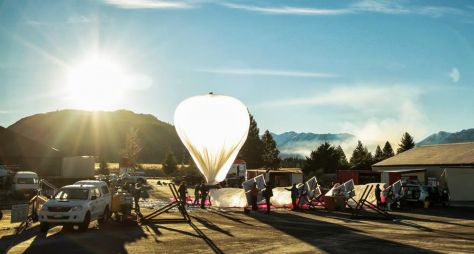June 17
New Zealand has backed Google’s balloon-powered internet project, set to encircle the globe.
Sending balloons into orbit from Christchurch, the internet search giant plans to beam internet access to billions as a result.

“The Internet is one of the most transformative technologies of our lifetimes,” says Mike Cassidy, Project Lead.
“But for two out of every three people on earth, a fast, affordable internet connection is still out of reach.
“And this is far from being a solved problem.”
Citing many terrestrial challenges to internet connectivity such as jungles, archipelagos, mountains, Cassidy also says there are major cost challenges.
“Right now, for example, in most of the countries in the southern hemisphere, the cost of an internet connection is more than a month’s income,” he says.
“Solving these problems isn’t simply a question of time: it requires looking at the problem of access from new angles.
“So today we’re unveiling our latest moonshot from Google
“We believe that it might actually be possible to build a ring of balloons, flying around the globe on the stratospheric winds, that provides Internet access to the earth below.
“It’s very early days, but we’ve built a system that uses balloons, carried by the wind at altitudes twice as high as commercial planes, to beam Internet access to the ground at speeds similar to today’s 3G networks or faster.
“As a result, we hope balloons could become an option for connecting rural, remote, and underserved areas, and for helping with communications after natural disasters.
“The idea may sound a bit crazy—and that’s part of the reason we’re calling it Project Loon—but there’s solid science behind it.”

Challenges
Balloons, with all their effortless elegance, do present some challenges however.
Many projects have looked at high-altitude platforms to provide internet access to fixed areas on the ground, but trying to stay in one place like this requires a system with major cost and complexity.
“The idea we pursued was based on freeing the balloons and letting them sail freely on the winds, Cassidy says.
“All we had to do was figure out how to control their path through the sky.
“We’ve now found a way to do that, using just wind and solar power: we can move the balloons up or down to catch the winds we want them to travel in.
“That solution then led us to a new problem: how to manage a fleet of balloons sailing around the world so that each balloon is in the area you want it right when you need it.
“We’re solving this with some complex algorithms and lots of computing power.”
But now Google needs some help, as the experiment is going to take way more than their team alone.
As a result, this week it started a pilot program in Canterbury with 50 testers trying to connect to Google balloons.
“This is the first time we’ve launched this many balloons (30 this week, in fact) and tried to connect to this many receivers on the ground, and we’re going to learn a lot that will help us improve our technology and balloon design.
“Over time, we’d like to set up pilots in countries at the same latitude as New Zealand.
“We also want to find partners for the next phase of our project—we can’t wait to hear feedback and ideas from people who’ve been working for far longer than we have on this enormous problem of providing Internet access to rural and remote areas.
“We imagine someday you’ll be able to use your cell phone with your existing service provider to connect to the balloons and get connectivity where there is none today.
“This is still highly experimental technology and we have a long way to go—we’d love your support as we keep trying and keep flying!”
Throwing his support behind the move, Christchurch Mayor Bob Parker said the area “couldn’t be prouder that Canterbury is the first place in the world to pilot this new technology from Google.”
